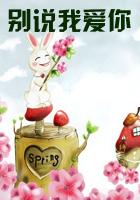Happy must the honeybees have been to find that the sweet clover, one of their dearest delights in the Old World, had preceded them in immigrating to the New.Immense numbers of insects - bees in great variety, wasps, flies, moths, and beetles - visit the little blossoms that provide entertainment so generous and accessible; but honey-bees are ever especially abundant.Slight weight depresses the keel, releasing the stigma and anthers therefore, so soon as a bee alights and opens the flower, he is hit below the belt by the projecting stigma.Pollen carried by him there from other clovers comes off on its sticky surface before his abdomen gets freshly dusted from the anthers, which are necessarily rubbed against while he sips nectar.On the removal of his pressure, the floret springs back to its closed condition, to protect the precious nectar and pollen from rain and pilferers.As the stigma projects too far beyond the anthers to be likely to receive any of the flower's own pollen, good reason is there for the blossoms guarding their attractions for the benefit of their friends, which transfer the vitalizing dust from one floret to another.By clustering its small flowers in spikes, to make them conspicuous, as well as to facilitate dining for its benefactors; by prolonging its season of bloom, to get relief from the fiercest competition for insect trade, and so to insure an abundance of vigorous cross-fertilized seed, this plant reveals at a glance some of the reasons why it has been able to establish itself so quickly throughout our vast area.
Both the white and the yellow sweet clover put their leaves to sleep at night in a remarkable manner: the three leaflets of each leaf twist through an angle of 90 degrees, until one edge of each vertical blade is uppermost.The two side leaflets, Darwin found, always tend to face the north with their upper surface, one facing north-northwest and the other north-northeast, while the terminal leaflet escapes the chilling of its sensitive upper surface through radiation by twisting to a vertical also, but bending to either east or west, until it comes in contact with the vertical upper surface of either of the side leaflets.Thus the upper surface of the terminal and of at least one of the side leaflets is sure to be well protected through the night; one is "left out in the cold."The dried branches of sweet clover will fill a room with delightful fragrance; but they will not drive away flies, nor protect woolens from the ravages of moths, as old women once taught us to believe.
The ubiquitous WHITE or DUTCH CLOVER (Trifolium repens), whose creeping branches send up solitary round heads of white or pinkish flowers on erect, leafless stems, from May to December, in fields, open waste land, and cultivated places throughout our area, Europe, and Asia, devotes itself to wooing bees, since these are the only insects that effect cross-fertilization regularly, other visitors aiding it only occasionally.When nets are stretched over these flowers to exclude insects, only one-tenth the normal quantity of fertile seed is set.Therefore, for the bee's benefit, does each little floret conceal nectar in a tube so deep that small pilferers cannot reach it; but when a honeybee, for example, depresses the keel of the papilionaceous blossom, abundant reward awaits him in consideration of his services in transferring pollen.After the floret which he has been the means of fertilizing closes over its seed-vessel on his departure, it gradually withers, grows brown, and hangs downward, partly to indicate to the next bee that comes along which fords in the head still contain nectar, and which are done for; partly to hide the precious little vigorous green seed-pod in the center of each withered, papery corolla from the visitation of certain insects whose minute grubs destroy countless millions of the progeny of less careful plants.Thus the erect florets in a head stand awaiting their benefactors; those drooping around the outer edge are engaged in the most serious business of life.Sometimes a solitary old maid remains standing, looking anxiously for a lover, at the end of the season.Usually all the florets are then bent down around the stem in a brown and crumpled mass.But however successfully the clover guards its seeds from annihilation, its foliage is the favorite food of very many species of caterpillars and of all grazing cattle the world around.This is still another plant frequently miscalled shamrock.Good luck or bad attends the finding of the leaves, when compounded of an even or an odd number of leaflets more than the normal count, according to the saying of many simple-minded folk.
The little RABBIT'S-FOOT, PUSSY, OLD-FIELD, or STONE CLOVER (T.
arvense) has silky plumed calices to hold its minute whitish florets, giving the dense, oblong heads a charming softness and dove color after it has gone to seed.Like most other clovers, it has come to us from the Old World.
FLOWERING SPURGE
(Euphorbia corollata) Spurge family Flowers - (Apparently) white, small, borne in forked, long-stalked umbels, subtended by green bracts; but the true flowers are minute, and situated within the white cup-shaped involucre, usually mistaken for a corolla.Staminate flowers scattered over inner surface of involucre, each composed of a single stamen on a thread-like pedicel with a rudimentary calyx or tiny bract below it.A solitary pistillate flower at bottom of involucre, consisting of 3-celled ovary; 3 styles, 2-cleft, at length forming an erect 3-lobed capsule separating into 32-valved carpels.Stem: 1 to 3 ft.high, often brightly spotted, simple below, umbellately 5-branched above (usually).Leaves:
Linear, lance-shaped or oblong, entire; lower ones alternate, upper ones whorled.
Preferred Habitat - Dry soil, gravelly or sandy.
Flowering Season - April-October.
Distribution - From Kansas and Ontario to the Atlantic.














